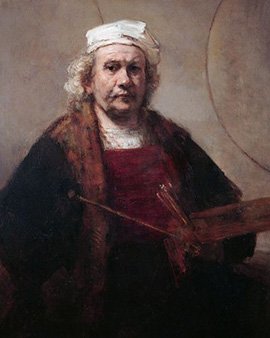The golden age of stands for a period of flourishing economy and a thriving economy. The wealth was accompanied by a great deal of freedom and the elevation of art to an economic sector. In early treatises on art, special emphasis is placed on a painter who was able to gain much from all three pleasant aspects of life. Rembrandt-van-Rijn loved prosperity and the extravagant life. As an artist he loved the freedom to realize his ideas and profited from the brisk trade in works of art. The highest good for the artist was painting, which he lived out like no other painter.
Already in the 17th century, Amsterdam set an example of liberality, tolerance and a unique cultural dynamic. Different languages were spoken in the streets and trade was part of the city's self-image. Rembrandt regularly moved to Amsterdam. At times his painting took on an entrepreneurial approach. His works are reminiscent of large scenes from a stage play. The figures are skilfully positioned and take centre stage through a skilful play of light. The Night Watch shows this play of light and dark to perfection. The painting shows a day scene and awakens in the viewer the feeling of an evening gathering. Rembrandt implemented the painterly principles of the Italian masters and developed a masterly manner of representation from them. Drama spoke from the paintings and he combined his figures with feelings. This becomes particularly clear in portraits in which he allowed his models and himself to laugh.
Rembrandt loved the opportunities his talent offered him. He founded his own workshop to paint and to have his paintings painted. Quite a few of his students' paintings bear the big name. The painter earned well and invested a considerable part of his money in paintings of other artists. He also bought his own paintings. In the hope of reselling them later at a profit, Rembrandt borrowed money. The painter lived in a complicated economic construct, which left the artist in his old age penniless. His treasury was dissolved and produced paintings by Rubens and Raphael. In the end, the great painter was left with painting and a life in a rare time of freedom.
×





.jpg)
.jpg)
.jpg)
.jpg)
.jpg)
.jpg)
.jpg)
.jpg)
.jpg)
.jpg)
.jpg)
.jpg)
.jpg)
.jpg)
.jpg)
.jpg)
.jpg)
.jpg)
.jpg)
.jpg)
 - (MeisterDrucke-587837).jpg)
 - (MeisterDrucke-587837).jpg)
.jpg)
.jpg)
.jpg)
.jpg)
.jpg)
.jpg)
.jpg)
.jpg)
.jpg)
.jpg)
.jpg)
.jpg)
.jpg)
.jpg)
.jpg)
.jpg)
 - (MeisterDrucke-50643).jpg)
 - (MeisterDrucke-50643).jpg)
_-_(MeisterDrucke-127101).jpg)
_-_(MeisterDrucke-127101).jpg)
 - (MeisterDrucke-89257).jpg)
 - (MeisterDrucke-89257).jpg)
.jpg)
.jpg)
.jpg)
.jpg)
.jpg)
.jpg)
.jpg)
.jpg)
 in Rich Costume - (MeisterDrucke-587502).jpg)
 in Rich Costume - (MeisterDrucke-587502).jpg)
.jpg)
.jpg)
.jpg)
.jpg)
.jpg)
.jpg)
.jpg)
.jpg)
.jpg)
.jpg)
.jpg)
.jpg)
 as Flora - (MeisterDrucke-609964).jpg)
 as Flora - (MeisterDrucke-609964).jpg)
.jpg)
.jpg)
.jpg)
.jpg)
.jpg)
.jpg)
.jpg)
.jpg)
.jpg)
.jpg)
.jpg)
.jpg)
.jpg)
.jpg)
.jpg)
.jpg)
 - (MeisterDrucke-37268).jpg)
 - (MeisterDrucke-37268).jpg)
.jpg)
.jpg)
.jpg)
.jpg)
_-_(MeisterDrucke-122126).jpg)
_-_(MeisterDrucke-122126).jpg)
.jpg)
.jpg)
.jpg)
.jpg)
.jpg)
.jpg)
.jpg)
.jpg)
.jpg)
.jpg)
.jpg)
.jpg)
.jpg)
.jpg)
.jpg)
.jpg)
_-_(MeisterDrucke-44208).jpg)
_-_(MeisterDrucke-44208).jpg)
.jpg)
.jpg)
.jpg)
.jpg)
.jpg)
.jpg)
.jpg)
.jpg)
.jpg)
.jpg)
.jpg)
.jpg)
.jpg)
.jpg)
.jpg)
.jpg)
.jpg)
.jpg)
.jpg)
.jpg)
_oil_on_-_(MeisterDrucke-943021).jpg)
_oil_on_-_(MeisterDrucke-943021).jpg)
.jpg)
.jpg)
_-_(MeisterDrucke-250117).jpg)
_-_(MeisterDrucke-250117).jpg)
.jpg)
.jpg)
_-_(MeisterDrucke-60199).jpg)
_-_(MeisterDrucke-60199).jpg)
.jpg)
.jpg)
.jpg)
.jpg)
.jpg)
.jpg)
.jpg)
.jpg)
.jpg)
.jpg)
.jpg)
.jpg)
.jpg)
.jpg)
.jpg)
.jpg)


 in Rich Costume - (MeisterDrucke-587501).jpg)
 in Rich Costume - (MeisterDrucke-587501).jpg)
.jpg)
.jpg)
.jpg)
.jpg)
.jpg)
.jpg)
.jpg)
.jpg)
.jpg)
.jpg)
.jpg)
.jpg)
.jpg)
.jpg)
.jpg)
.jpg)
.jpg)
.jpg)
.jpg)
.jpg)
.jpg)
.jpg)
.jpg)
.jpg)
.jpg)
.jpg)
.jpg)
.jpg)
.jpg)
.jpg)
.jpg)
.jpg)
.jpg)
.jpg)
.jpg)
.jpg)
.jpg)
.jpg)
.jpg)
.jpg)






